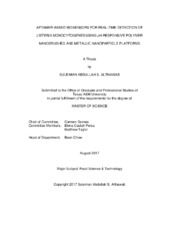| dc.description.abstract | Listeria monocytogenes is the third most frequent cause of death from foodborne illnesses in the United States. Conventional methods for detecting L. monocytogenes are time-consuming and require highly trained personnel and certified laboratories. Therefore, a highly sensitive and easy to use biosensor as a rapid detection method for foodborne pathogen is needed to ensure food safety and public health. The objective of this project was to design electrochemical biosensors based on the combination of platinum nanoparticles (n-Pt), pH-responsive polymer nanobrushes including, chitosan (CHI), alginate (ALG) and polyacrylic acid (PAA)), and aptamers for improved detection of L. monocytogenes. n-Pt was deposited onto electrodes using a pulsed sonoelectrodeposition (pulSED) method, which increased (P < 0.05) the electroactive surface area (ESA) from 0.018 ± 0.0004 cm2 to 0.081 ± 0.0179 cm2. Then, pH-responsive polymer brushes were electrodeposited onto the n-Pt. The optimized nanobrushes deposition increased (P<0.05) ESA to 0.101 ± 0.004 cm2, 0.111 ± 0.012 cm2, and 0.108 ± 0.022 cm2 for CHI, ALG and PAA/n-Pt modified electrodes, respectively. Aptamers selective to L. monocytogenes were loaded onto the nanobrushes at 1000 nM, 400 nM, and 800 nM for CHI/n-Pt, PAA/n-Pt, and ALG/n-Pt electrodes, respectively. Loading aptamers onto the pH-responsive nanobrushes improved (P < 0.05) biosensors performance, as they were actuated to extend during the bacteria capturing step and contract during the sensing process. The developed biosensors were tested in buffer and a food matrix against another Gram-positive bacteria (Staphylococcus aureus) and showed a wide detection range of 101-108 CFU/mL of L. monocytogenes in 17 min. The 1000-nM-aptamer/CHI/n-Pt biosensors provided the lowest average of limits of detection (LODs), 1.37 ± 1.50 CFU/mL with a sensitivity of 7.27 ± 1.10 (1/log(CFU/mL)) based on charge transfer resistance (Rct) changes. Conversely, the 400-nM-aptamer/ALG/n-Pt biosensors provided the most consistent results with LODs of 6.10 ± 1.95 CFU/mL and sensitivity of 5.97 ± 0.90 (1/log(CFU/mL)) based on Rct data, respectively. The combination of aptamers and pH-responsive nanobrushes on n-Pt provided enhanced sensing performance over other published biosensors without requiring addition of reagents or sample pre-incubation. | en |


